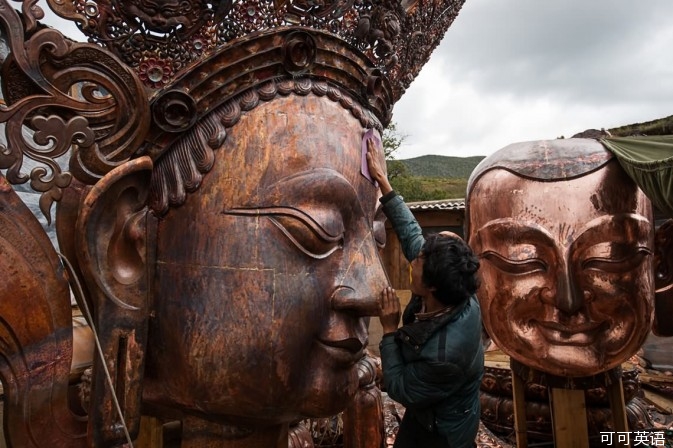(单词翻译:单击)

It takes a lot of work to capture a good photo. Last month, Michael Yamashita was sitting in a Hong Kong bookstore, clicking through slides of pictures from his new book, Shangri-La: Along the Tea Road to Lhasa, a five-year project that documents the incomparable beauty and changing face of Tibet.
捕捉一张好照片需要大量的工作。上个月,Michael Yamashita坐在香港的书店里,点击着他的新书《寻访香格里拉:探索失落的茶马古道》里的幻灯照,一个的五年的课题,记录了西藏无与伦比的美丽和不断改变的面貌。

He arrived at a photo of several young men dressed in leather aprons and heavy mittens, with plastic covers on their shoes, making their way down an empty road high on the Tibetan plateau. One of them was lying prostrate on the ground, another rising to his feet, others walking forward. They were pilgrims making an arduous month-long journey to Lhasa.
他来到一张照片前:几个年轻人穿着皮革围裙戴着沉重的连指手套并用塑料套在他们的鞋子上,在青藏高原空旷的道路上行走。其中一个匍匐着躺在地上,另一个正站起来,其他人在向前走。他们是用长达一个月的时间艰难前往拉萨的朝圣者。
"To get this frame that's perfect, with one guy on the ground, another rising, other standing, I must have had to walk half a mile backwards," said Yamashita. "And it was raining."
“得到这张照是完美的,一个家伙在地上,另一个在站起来,其他人站着,我必须得向后走半英里,” Yamashita说。“当时还在下雨。”
Later, I asked him how far he has gone to get a single shot. "I wouldn't risk my life, but it's all about getting the picture," he said. "You'll do what you have to do."
后来,我问他要走多远才能有一次摄影。“我不会冒着生命危险,但都是关于得到照片,”他说。“你会去做你不得不做的事情。”

Shangri-La is one of those projects. Yamashita has been travelling to Tibet for 15 years and the photos in the book were taken over a period of five years.
香格里拉是其中一个课题。Yamashita已经在西藏旅行了15年,书中这些照片是超过五年时间拍摄的。
Like all of his projects, this one began with research. "I've read just about every book that was ever published on Tibet," says Yamashita. "We don't have time to mess around. There's nothing left to chance – we go at the right time to get the right people in the right pictures."
像所有的课题一样,这个也从研究开始。“我只是已经读过出版过的每一本关于西藏的书” Yamashita说。“我们没有时间浪费。天上不会掉馅饼——我们走在恰当的时间把恰好的人记录在正好的照片里。”

More than landscapes, though, it's the human geography that fascinates Yamashita. In Jiuzhaigou, for example, tea is grown, harvested, dried and hand-processed into bricks. "This is why I'm drawn back to China again and again – the fashion may have changed – the cities certainly have – but certain practices are exactly the same as they've been for centuries."
但不只是风景,令Yamashita着迷也有人文地理。例如,在九寨沟茶叶生长、收获、烘干并且手工加工成砖块。“这就是为什么我一次次被吸引回到中国——方式可能已经改变——城市当然有,但某些习惯完全相同因为他们已经存在了几个世纪。”


